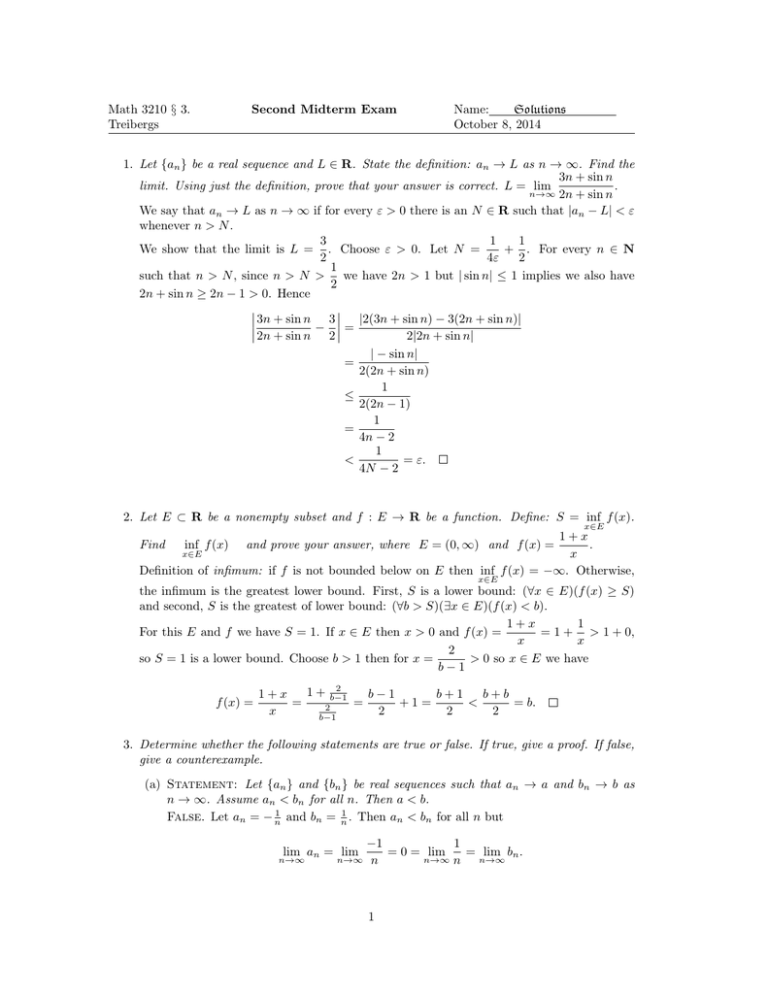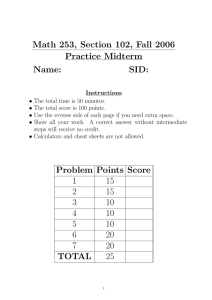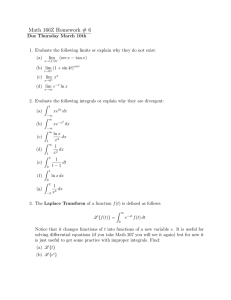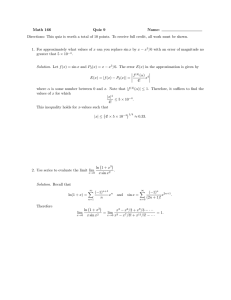Math 3210 § 3. Second Midterm Exam Name: Solutions
advertisement

Math 3210 § 3.
Treibergs
Second Midterm Exam
Name:
Solutions
October 8, 2014
1. Let {an } be a real sequence and L ∈ R. State the definition: an → L as n → ∞. Find the
3n + sin n
limit. Using just the definition, prove that your answer is correct. L = lim
.
n→∞ 2n + sin n
We say that an → L as n → ∞ if for every ε > 0 there is an N ∈ R such that |an − L| < ε
whenever n > N .
3
1
1
We show that the limit is L = . Choose ε > 0. Let N =
+ . For every n ∈ N
2
4ε
2
1
such that n > N , since n > N > we have 2n > 1 but | sin n| ≤ 1 implies we also have
2
2n + sin n ≥ 2n − 1 > 0. Hence
3n + sin n 3 |2(3n + sin n) − 3(2n + sin n)|
2n + sin n − 2 =
2|2n + sin n|
| − sin n|
=
2(2n + sin n)
1
≤
2(2n − 1)
1
=
4n − 2
1
= ε.
<
4N − 2
2. Let E ⊂ R be a nonempty subset and f : E → R be a function. Define: S = inf f (x).
x∈E
1+x
Find
inf f (x) and prove your answer, where E = (0, ∞) and f (x) =
.
x∈E
x
Definition of infimum: if f is not bounded below on E then inf f (x) = −∞. Otherwise,
x∈E
the infimum is the greatest lower bound. First, S is a lower bound: (∀x ∈ E)(f (x) ≥ S)
and second, S is the greatest of lower bound: (∀b > S)(∃x ∈ E)(f (x) < b).
1
1+x
= 1 + > 1 + 0,
For this E and f we have S = 1. If x ∈ E then x > 0 and f (x) =
x
x
2
so S = 1 is a lower bound. Choose b > 1 then for x =
> 0 so x ∈ E we have
b−1
f (x) =
2
1 + b−1
1+x
b−1
b+1
b+b
=
=
+1=
<
= b.
2
x
2
2
2
b−1
3. Determine whether the following statements are true or false. If true, give a proof. If false,
give a counterexample.
(a) Statement: Let {an } and {bn } be real sequences such that an → a and bn → b as
n → ∞. Assume an < bn for all n. Then a < b.
False. Let an = − n1 and bn = n1 . Then an < bn for all n but
−1
1
= 0 = lim
= lim bn .
n→∞ n
n→∞ n
n→∞
lim an = lim
n→∞
1
(b) Statement: |x| ≥ |y| − |x − y| for all x, y ∈ R.
True. By the triangle inequality we have
|y| = |x + (y − x)| ≤ |x| + |y − x|.
(c) Statement: Let {xn } be a real sequence. Suppose for every L ∈ R there is an n ∈ N
such that xn > L. Then lim xn = ∞.
n→∞
False. The given condition is for unboundedness above. The definition of lim xn =
n→∞
∞ is: (∀L ∈ R)(∃N ∈ R)(∀n ∈ N)(n > N =⇒ xn > L).
Thus a counterexample is given by
(
n, if n is even;
xn =
0, if n is odd.
The condition holds: for every L ∈ R there is m ∈ N such that m > L by the
Archimidean Property, so n = 2m > L and xn = n > L since n is even, but the limit
is not infinite. For L > 0 it is not true that there is an N ∈ R such that xn > L for
all n > N because, no matter what N is, there are odd numbers n with n > N , such
that xn = 0 which is not greater than L.
4. Let {an } be a real sequence and a ∈ R. Suppose an → a as n → ∞. Using just the definition
of limit (and not the Main Limit Theorem), show that cube sequence converges
(an )3 → a3
as n → ∞.
Choose ε > 0. Since an → a, for ε0 = 1, there is an N1 ∈ R such that
|an − a| < ε0 = 1,
whenever n > N1 .
For such n we have by the triangle inequality
|an | = |a + (an − a)| ≤ |a| + |an − a| < |a| + ε0 = |a| + 1.
Also since an → a, for ε00 =
ε
there is N2 ∈ R such that
3(|a| + 1)2
|an − a| < ε00 =
ε
3(|a| + 1)2
whenever n > N2 .
Let N = max{N1 , N2 }. For any n ∈ N satisfying n > N , since n > N1 we have |an | ≤ |a|+1
and since also n > N2 ,
|a3n − a3 | = |(an − a)(a2n + an a + a2 )|
≤ |an − a| |an |2 + |an | |a| + |a|2
≤ |an − a| · (|a| + 1)2 + (|a| + 1)|a| + |a|2
≤ |an − a| · 3(|a| + 1)2
ε
· 3(|a| + 1)2 = ε.
<
3(|a| + 1)2
2
5. Define a sequence recursively by a1 = 1 and an+1 = 1 −
{an } converges. What is lim an ? Why?
1
. Prove that the sequence
2 + an
n→∞
5
13
2
. a3 = . a4 =
, which suggests
3
8
21
an is decreasing. We shall show that {an } is decreasing and bounded below. Hence, by the
Monotone Convergence Theorem, there is a ∈ R such that an → a as n → ∞.
Computing the first several terms we find a1 = 1, a2 =
First we show that an > 0 for all n ∈ N so that {an } is bounded below by zero. Argue by
induction. Base case: the first term is defined a1 = 1 so it is greater than zero. Induction
case: assume for some n ∈ N that an > 0. Then
an+1 = 1 −
1
1 + an
(+)
=
=
>0
2 + an
2 + an
(+)
since both numerator and denominator are positive by the induction hypothesis. This
completes the argument that an > 0 for all n ∈ N.
Next we show that an is decreasing by induction. Base case: we have
a2 = 1 −
2
1
1
= < 1 = a1
=1−
2 + a1
2+1
3
so that a2 − a1 < 0. Induction case: assume that for any n ∈ N we have an+1 − an < 0.
Then
1
1
an+2 − an+1 = 1 −
− 1−
2 + an+1
2 + an
−(2 + an ) + (2 + an+1 )
=
(2 + an+1 )(2 + an )
an+1 − an
=
(2 + an )(2 + an+1 )
(−)
=
< 0,
(+)(+)
where we have used the induction hypothesis on the numerator and the positivity of an in
the denominator. This completes the argument that an is decreasing.
Finally, we compute a. By the Subsequences Theorem we see that an+1 → a as n → ∞.
Taking limits of both sides of the recursion equation yields by the Main Limit Theorem,
1
1
a = lim an+1 = lim 1 −
=1−
.
n→∞
n→∞
2 + an
2+a
Solve for a by cross multiplying a(2 + a) = (2 + a) − 1 so a2 + a − 1 = 0. By the quadratic
formula
p
√
−1 ± 12 − 4 · 1 · (−1)
−1 ± 5
a=
=
.
2
2
Since an > 0 for all n we have a = lim an ≥ 0 so only the positive root gives the limit
n→∞
√
1
5
a=− +
= 0.61803.
2
2
3








